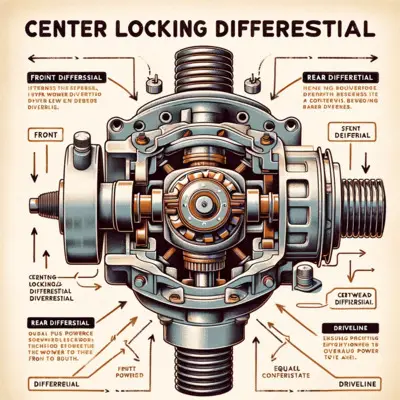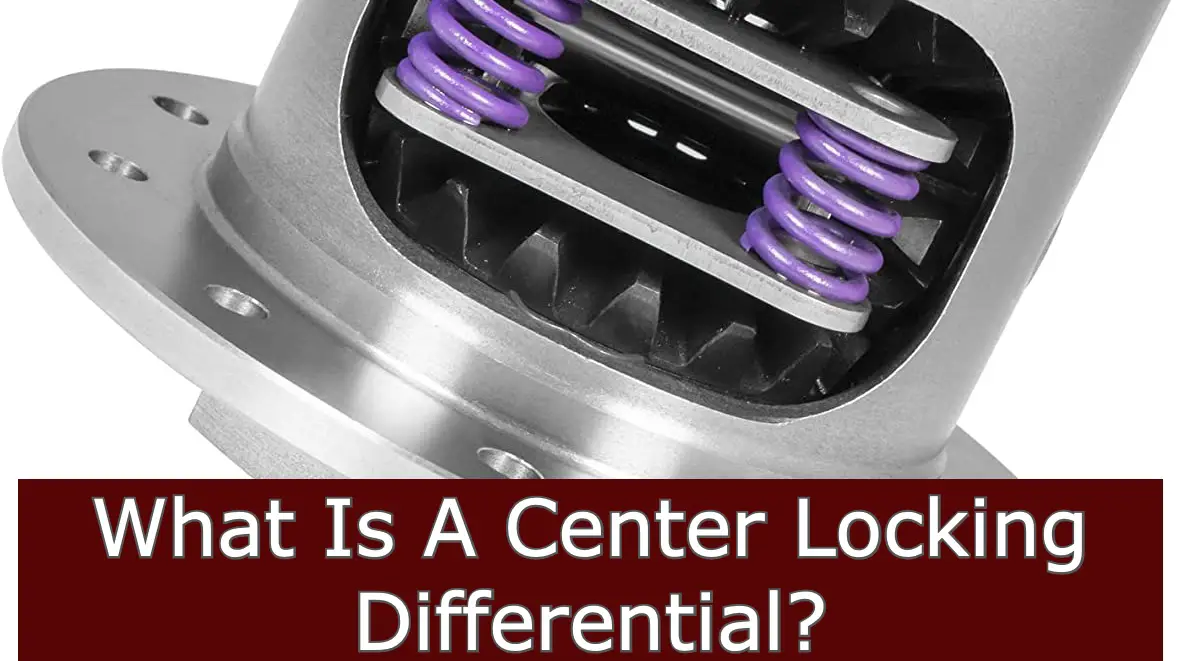Several vehicle manufacturers have created new technologies because general mechanisms were so widespread. It’s key to gain an understanding of these basic principles before learning about advanced concepts. No doubt, the locking differential is one of the most complex components of vehicles.
If you drive a car with a center-locking differential, you’re using a type of differential that can lock up when one wheel is in a deeper hole than the other. This prevents the wheel with less traction from spinning, ensuring that you stay on the road and don’t lose control.
Do not let yourself get bogged down by this information. We will make it simple, so you can quickly interpret what is a center-locking differential and what it does. Today, we are going to talk about a general factor that will make it simpler to comprehend.
What Is A Center Locking Differential?

A Center Locking Differential, as the name implies, is located between the front and rear differentials on the LandCruiser 200 Series wagon with all-wheel drive and constant 4WD. Unlike front and rear differentials, where scramble power is 50-50 blessed to have made it to each axle, participating in a center differential, alternating power is 50-50 thankful that each axle.
This type of locking differential uses a pinion and ring gear arrangement to allow the car to move forward or backward, but not rotate. At the same time, it allows the wheels on one side of the car to rotate at different speeds than the wheels on the other side, which makes it much easier to control the car while driving.
As we mentioned earlier, center-locking differentials are usually found in sports cars and luxury vehicles, as they provide increased handling and stability. When shuttling is in the mode of aversion, the vehicle may indicate which side of the vehicle is traveling by turning the steering wheel.
Alternatively, if the center differential is present, the vehicle can drive all four wheels simultaneously, but the power to each wheel is delivered to the wheel with the least traction.
How Does Center Differential Lock Work
A center differential lock distributes vehicle power equally between the right and left rear wheels of a vehicle. It does this by varying the engine’s power flow and distributing it between the two axles.
If you don’t want to get stuck somewhere on the road due to an issue with the differential or components of the automobile’s drive mechanism, then you should contemplate this component in detail.
Center diff locks that are only intended for all-wheel (AWD) or constant 4WD vehicles or automobiles that have the possibility of sending that type of drive are on offer. With a part-time four-wheel-drive truck or Land Cruiser, the front-wheel-drive is in these two cases until the driver masses 4H or 4L.
The four-wheel-drive transfer case they share reacts to command inputs of 4H or 4L, moves them into position, and allows them to be used 50 percent front to rear.
Driving a part-time four-wheel drive in four-wheel-high on a substrate, for example, cement or a tar road, with a diff-lock lock switched off, all four tires will move at different speeds and will traverse dissimilar distances. Fixed tilt Rolley trucks are supposed to manually pull the handle up and down using a lever.
This practice can nonetheless wreak havoc on a transfer case’s axle, so it requires forethought to avoid making contact with the device. The reason why transfers don’t “wind up” is that you’re supposed to relieve pressure on these devices through manual compression.
Now, most AWDs have a transfer case in which they have functionality built into the piece to redirect further drive to the front and rear axles but still permit the axles to run at different speeds so that you are able to turn around or climb hills, often an open differential of the website, but of necessity a smaller wheel than the left and right end differentials.
If the Center Diff is unlocked, it is generally an open diff, so it really only provides drive to that point on the vehicle whose traction is the least, although the setting may not change, an AWD Vehicle with the Center Diff unlocked is actually just driving the larger wheel at the instant (it is the least traction-free).
When To Use Center Differential Lock
We have already discussed the operating principle of the center diff lock and as it is sophisticated and powerful, you might be wondering about the best ways to use a car whose differential system is engaged. Well, let us examine several of the benefits of utilizing this system in both on- and off-road conditions, so you can see how effective it is in particular aspects.
On-Road Driving
Center differential locks enhance power transfer by shifting motivation from the kick-up wheel to the driving wheels. That means the center differential lock enhances performance for four-wheeled vehicles.
Because of their greater traction, center differential locks make driving much easier. This attribute allows for the use of increased torque on the driving wheels of the vehicle when equipped with one.
When you’re driving on a regular street, ungated terrain may not be an important consideration. Ground driving has its own beneficial properties as long as you aren’t missing a center differential lock. If you plan on doing a lot of driving on the road, then you do not need a central differential lock system.
There are nonetheless some situations, where a center differential lock will be useful even if you’re doing your day-to-day driving on the road. With different conditions like snow and ice, it’s necessary to put a differential locking system in the vehicle. A clever and well-built traction system makes driving in dense snow and ice a lot easier.
Assuming this more torque is going into the wheels and more force is often directed to where it is most beneficial, the zero slippage of snow will enable you to navigate easily across this surface, which stems from the motion of rotating at different speeds depending on the size of the wheels as well as the mass of torque.
So, if you keep driving on a clear road, and you do not have any intention of driving on uneven terrain, then you don’t need, you avoid purchasing a center differential lock system.
Off-Road Driving
Now, this is what the center differential lock is known for. The center diff lock system’s main goal is so that it is able to generate equal amounts of torque between the front and rear axles. We have probably already mentioned that the center diff lock system is used for activities that are off the road.
The fact you will get one wheel in the front moving and another wheel in the rear moving will always be the same regardless of the setting of your car. It offers more comfortable control of the terrain, and you can easily choose a direction among the steep and muddy areas.
When driving along a terrain that is both difficult to drive and muddy, you often have to drive to it from the opposite side of the vehicle. This will permit your vehicle to function more smoothly, which will facilitate driving this tremendously on steep and muddy terrain.
The center differential system enables you to split the drive power through the independent front and rear driveshafts. We have already mentioned the fact that this gives you more control over your vehicle’s wheels and generally results in a better driving experience.
When your vehicle is outfitted with an antilock brake controller (ABS) but not in a car diff lock system, it is best to have it when you are driving on mud or rock roads. In short, Before you go up in off-roading, it’s important to have a center differential lock system where you can switch to a four-wheel drive to enjoy even the challenging situation.
Frequently Asked Questions
What is the purpose of a center-locking differential?
The center differential frees up the drivetrain to allow the vehicle to respond better in turns. You slightly lose the capacity to steer (out of inhibition on gas when the power flows to the front), but this can better your control of the car. The root cause of the devotional effect is it may send extra power to the front wheels.
What does a center diff lock do?
In conditions of poor traction, the diff lock keeps all the wheels rotating at the same speed, regardless of the front-to-rear wheel differential. This is handy when you’re confronted with difficult terrain and require one or more wheels to remain on the ground, so you don’t completely lose ground or drift off course.
Can you turn with the center diff locked?
At the moment of cornering, your rear axle travels less compared to the front axle, thus the rotation becomes much quicker. However, when your center diff lock is engaged, the scenario doesn’t remain the same because both axles take turns at the same time.
How fast can you drive with the center diff locked?
Theoretically, you can drive as fast as you want with the center diff locked. However, in practice, the diff will usually limit your speed to around 60-70 mph.
Final Words
At this point, you might have learned what is a center-locking differential and some other basics. In short, a center-locking differential is a great choice for those who want to maximize traction and handling while driving. It is also a great option for off-road enthusiasts, as it can handle difficult terrain with ease. If you are looking for a differential that will improve your driving experience, a center-locking differential is a perfect option for you.
